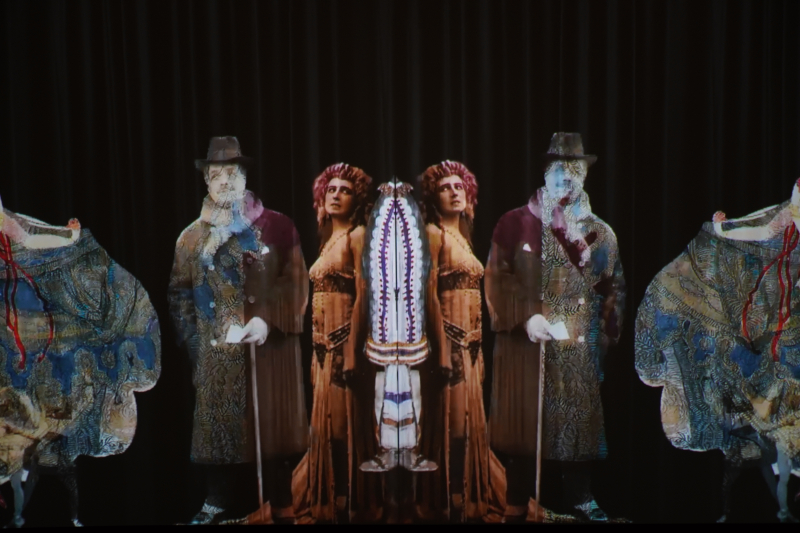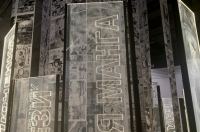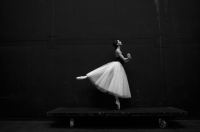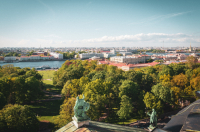From the very entrance, suspense is building: this time, the space inside the exhibition hall is organized in a way that doesn’t allow you to see what lies beyond the foyer. Adding to the anticipation are the headphones given to you at the start – is it an audio guide or part of some immersive experience?
Needless to say, I was excited beyond measure and planned this visit in advance with several of my friends who are ballet enthusiasts. Over the years of visiting the Mariinsky Theater with them, I have come to feel a certain gap in my ballet expertise and was rather keen on filling it in – so that’s what I expected to do at the exhibition.
Patchy history
Finally stepping inside the hall, I found myself in a dimly lit space, much like a theater during a performance, with occasional displays and texts hung along the burgundy walls, their color reminiscent of theater chairs. In my headphones, as I moved throughout the exhibition, I heard pieces from some of the best-known ballets – Romeo and Juliet, The Nutcracker, Swan Lake…
This section was all about the early history of ballet in general and the start of its traditions in Russia. I have to admit that, apart from an impressive moving mockup of a theatrical set from Le Corsaire, one of the most tech-laden ballets of its time, this first part left me with a weird mismatched impression.
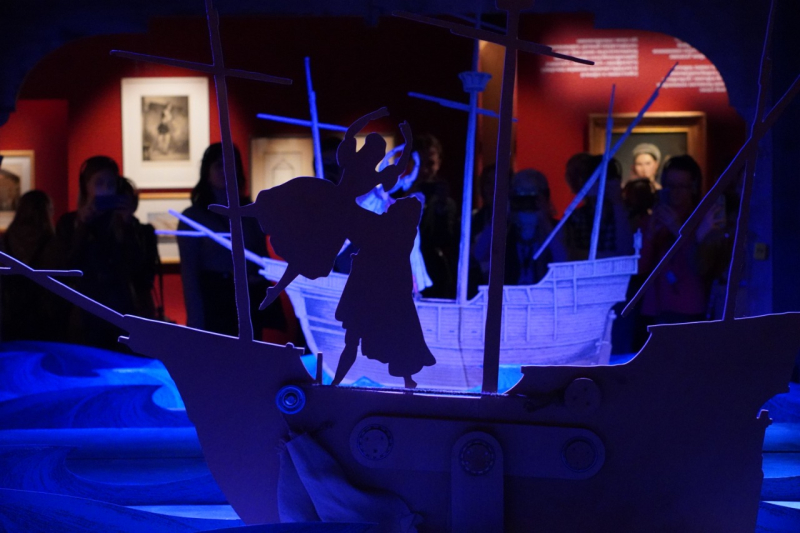
The moving mockup of Le Corsaire. Photo by Ivan Myakishev for ITMO.NEWS
Next followed a spacious and well-lit area devoted to the Ballets Russes, a ballet company founded by Sergei Diaghilev that caused a small revolution in the visual and performing arts: essentially, it brought together outstanding dancers, composers, and visual artists to deliver spectacular ballet performances in Europe and North and South America. Looking back on it now, I can see how the hall was meant to symbolize the world of ballet expanding as Russian dancers toured the world, becoming immensely popular. Hence, to underline the significance of this act, the visitors were treated to a slightly excessive display of costumes, theatrical scenery, and even one of the earliest video recordings of Anna Pavlova. A highlight of this part for me? Stravinsky’s Petrushka blasting in the headphones.
From this roomy hall, we headed into a corridor-like space, this one illustrating the fate of ballet in the Soviet times. I believe that this part would have been most confusing for any international visitor, while for me, it served as one more reminder that art and restrictive laws do not and should not go together. This overview ended with closeups of contemporary star performers – unfortunately, with no information about their achievements or significance.
Details to a T
The whole second floor of the exhibition was meant to give anyone new to ballet a thorough introduction to the art. This was the most interactive and comprehensive part of the exhibition. Here, you could attend a beginner ballet class to dip into its atmosphere, learn more about the leg and arm movements – their names, history, and some fun facts – as well as discover the background of the classical ballet techniques developed in Russia.
Another hall had a rather curious technical approach to the art form: visitors were treated to slow-motion videos of performers with detailed information about the calories spent on each movement and the muscles involved. Having seen all the activated muscle groups, I will now never doubt that ballet is indeed hard work!
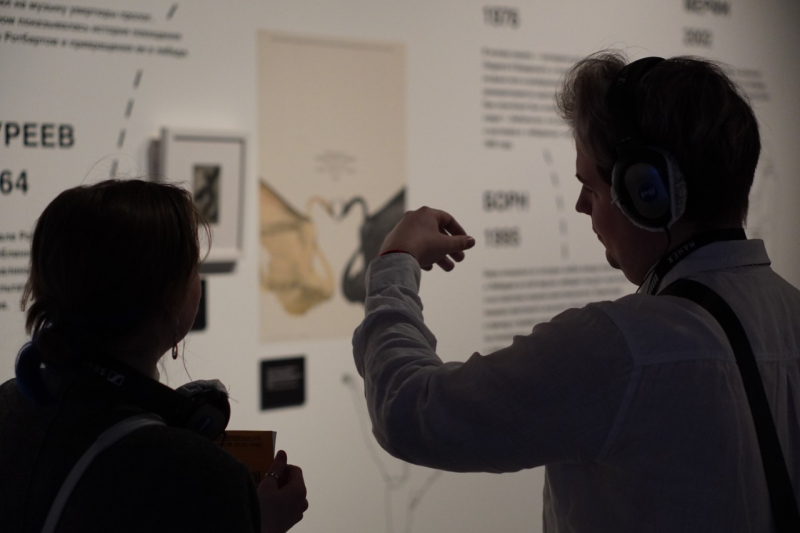
Photo by Ivan Myakishev for ITMO.NEWS
Then, after a hall filled with pearly white ballerina suits – as they changed through the ages of ballet – we stepped into the final room of the exhibition, devoted entirely to Swan Lake. Given the ballet’s popularity, I shouldn’t have been surprised by the amount of variations it has seen through the ages – but I was positively stunned. From Gatsby-style renditions to upside-down arm dances, when a piece is that wide-known it, apparently, can be recognized no matter what.
And to the sounds of, bafflingly, Dance of the Knights from Prokofiev’s Romeo and Juliet, out of the exhibition hall we strolled.
First… impressions
So, did I fill in the gaps in my ballet knowledge? Yes and no.
Where I was craving a general overview of the history of the art form, I had to do with some rather haphazard pieces of information that didn’t quite come together into a coherent story. However, I do feel that in terms of technique and certain key ballet movements, I am now a little bit of an expert.
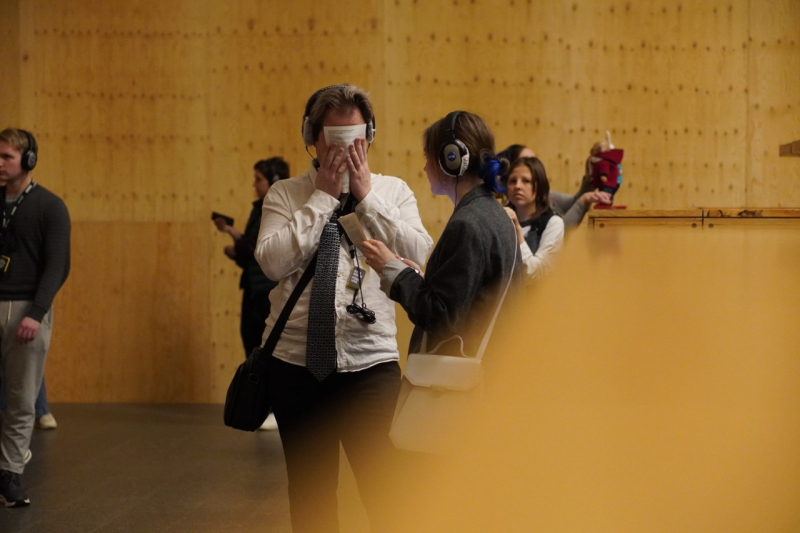
My friend and I at the exhibition. Photo by Ivan Myakishev for ITMO.NEWS
Otherwise, I was left with an impression that instead of welcoming the public into the world of ballet, the exhibition turned it into an even more complicated and distant phenomenon. Somehow, by omitting any kind of coherent narrative but rather choosing to emphasize the awe-inspiring aspects of ballet, the curators only added to the impression that this art form is only for the chosen few. A little disconcerted by my feelings, I turned to my friend, a PhD student and lecturer at St. Petersburg State University, whose opinion on art I greatly value, for his comment. Here’s what he shared:
“Having anticipated the exhibition, I was dejected to find myself at another myth-making factory of Russian ballet. The curators told us once again a glorious story of the "national treasure," highlighting everything Russian and erasing everything foreign from their narrative, including the Russian principal dancers who emigrated in the 20th century. For me, First Position (the name speaks for itself) was more about boasting than about seriously reflecting on our undoubted cultural pride. Still, I must admit that the project is grand and technically advanced, so it has a strong potential to inspire those not very familiar with the art to explore the subject further.”
And now to the main question: should you visit the show? If you know nothing at all about ballet, then it might give you some insights into the art form or prepare you for your first visit to a performance. However, if you are already a fan of ballet, you can probably invest your money into some tickets instead (especially with a student discount from ITMO Intelligentsia).
Follow our weekend guides to be among the first to learn about each weekend’s top events.
